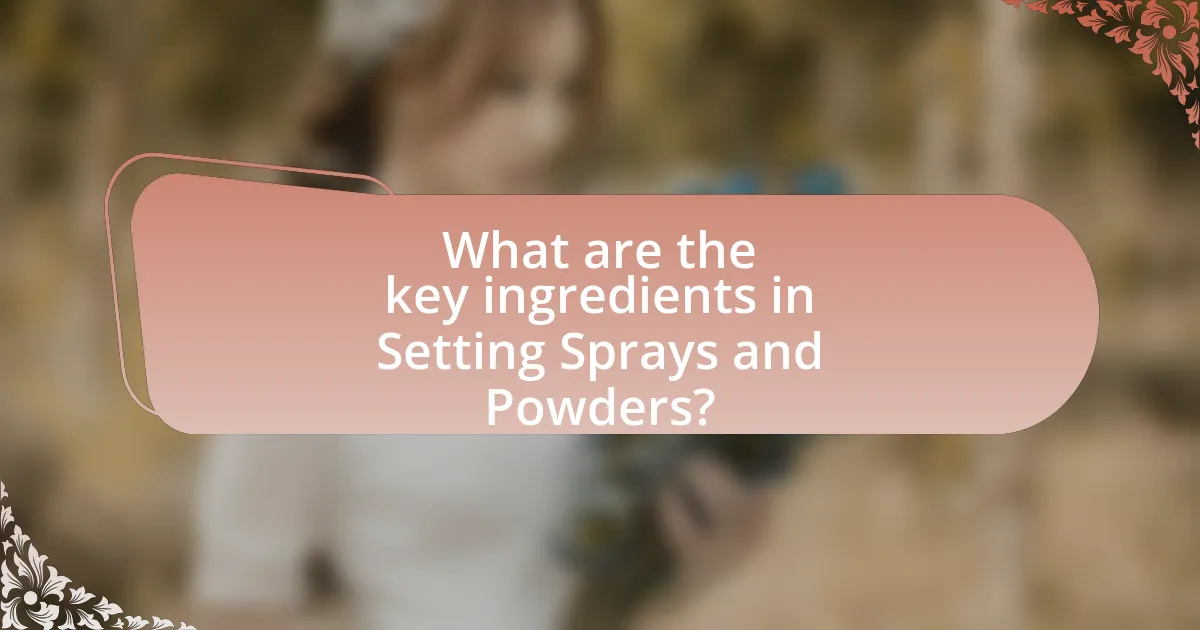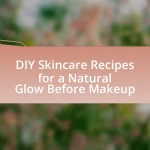Setting sprays and powders are essential cosmetic products designed to enhance the longevity and appearance of makeup. This article explores their functions, key ingredients, and differences from other makeup products, emphasizing their role in preventing smudging and fading. It also discusses how to choose the right setting spray or powder based on skin type and desired finish, as well as best practices for application. Additionally, the article highlights common mistakes to avoid and the impact of formulation on performance, providing a comprehensive understanding of these makeup essentials.

What are Setting Sprays and Powders?
Setting sprays and powders are cosmetic products designed to prolong the wear of makeup. Setting sprays are liquid formulations that are applied after makeup application to create a protective barrier, helping to lock in makeup and reduce fading or smudging throughout the day. Powders, on the other hand, are typically used to absorb excess oil and provide a matte finish, further enhancing makeup longevity. Both products often contain ingredients like silicones or polymers that contribute to their effectiveness in maintaining makeup appearance over time.
How do Setting Sprays and Powders differ from other makeup products?
Setting sprays and powders differ from other makeup products primarily in their function of prolonging makeup wear and enhancing its finish. Unlike foundation or concealer, which provide coverage and color, setting sprays and powders are specifically designed to lock makeup in place, preventing smudging and fading throughout the day. Setting sprays often contain ingredients like glycerin or alcohol that create a barrier on the skin, while powders absorb excess oil and provide a matte finish. This distinction is crucial as it addresses the need for longevity and stability in makeup application, which is supported by consumer preferences for long-lasting products in the beauty industry.
What are the primary functions of Setting Sprays?
Setting sprays primarily function to lock in makeup, ensuring its longevity and preventing smudging or fading throughout the day. These sprays create a protective barrier over the makeup, which helps to maintain its appearance under various conditions such as humidity or heat. Additionally, many setting sprays contain ingredients that can hydrate the skin or provide a matte finish, further enhancing the overall look and feel of the makeup.
What are the primary functions of Setting Powders?
Setting powders primarily function to set makeup, control shine, and enhance longevity. By absorbing excess oil and moisture, setting powders help maintain a matte finish throughout the day. Additionally, they create a smooth surface that minimizes the appearance of fine lines and pores, ensuring that makeup remains intact and looks fresh. Studies indicate that the use of setting powders can significantly extend the wear time of foundation and concealer, making them a crucial component in makeup routines for achieving a polished look.
Why are Setting Sprays and Powders important in makeup application?
Setting sprays and powders are crucial in makeup application because they enhance longevity and maintain the desired finish of the makeup. These products create a barrier that helps to lock in makeup, preventing it from fading, smudging, or settling into fine lines throughout the day. Studies indicate that setting sprays can extend makeup wear by several hours, with some formulations containing ingredients like silica or polymers that absorb excess oil and moisture, further stabilizing the makeup. This functionality is essential for achieving a polished look that lasts, especially in varying environmental conditions.
How do they enhance makeup longevity?
Setting sprays and powders enhance makeup longevity by creating a protective barrier that locks in makeup and reduces the effects of environmental factors. These products contain ingredients such as polymers and film-forming agents that adhere to the skin and makeup, preventing smudging, fading, and wear throughout the day. For instance, studies have shown that setting sprays can extend the wear time of makeup by several hours, with some formulations providing up to 16 hours of durability. This effectiveness is attributed to their ability to absorb excess oil and moisture, which can otherwise break down makeup.
What role do they play in achieving a flawless finish?
Setting sprays and powders play a crucial role in achieving a flawless finish by locking in makeup and controlling shine. These products create a barrier that helps to prevent makeup from smudging or fading throughout the day, ensuring a long-lasting appearance. For instance, studies have shown that setting sprays can reduce makeup wear time by up to 16 hours, while powders can absorb excess oil, providing a matte finish. This combination of locking in color and controlling shine is essential for maintaining a polished look.

What are the key ingredients in Setting Sprays and Powders?
The key ingredients in setting sprays and powders typically include water, alcohol, and various film-forming agents. Water serves as a base for hydration, while alcohol helps to evaporate quickly, setting makeup in place. Film-forming agents, such as polymers like PVP (polyvinylpyrrolidone) or acrylates, create a thin layer on the skin that locks in makeup and enhances longevity. Additionally, setting powders often contain silica or talc, which absorb excess oil and provide a matte finish. These ingredients work together to ensure that makeup remains intact throughout the day, providing both durability and a polished appearance.
What common ingredients are found in Setting Sprays?
Common ingredients found in setting sprays include water, alcohol, glycerin, and various polymers. Water serves as the primary solvent, while alcohol helps to quickly evaporate and set makeup. Glycerin acts as a humectant, attracting moisture to the skin, and polymers create a film that locks makeup in place. These components work together to enhance the longevity and finish of makeup applications, ensuring a more durable and polished look.
How do these ingredients contribute to the effectiveness of Setting Sprays?
Setting sprays are effective due to their key ingredients, which typically include polymers, humectants, and alcohol. Polymers create a film on the skin that helps lock in makeup, providing a barrier against moisture and environmental factors. Humectants, such as glycerin, attract moisture to the skin, ensuring that makeup remains hydrated and reduces the likelihood of cracking or fading. Alcohol serves as a solvent that helps the other ingredients to evaporate quickly, allowing for a fast-drying finish that sets the makeup in place. These components work synergistically to enhance the longevity and appearance of makeup throughout the day.
Are there any harmful ingredients to avoid in Setting Sprays?
Yes, there are harmful ingredients to avoid in setting sprays. Common harmful ingredients include alcohol denat, which can cause skin irritation and dryness, and parabens, which are linked to hormonal disruptions. Additionally, synthetic fragrances can trigger allergic reactions and sensitivities in some individuals. Avoiding these ingredients can help ensure a safer application and minimize potential adverse effects on the skin.
What common ingredients are found in Setting Powders?
Common ingredients found in setting powders include talc, silica, and mica. Talc is often used for its oil-absorbing properties, helping to reduce shine on the skin. Silica provides a lightweight texture and enhances the powder’s ability to absorb moisture, contributing to a matte finish. Mica adds a subtle shimmer and helps to reflect light, improving the overall appearance of the skin. These ingredients are widely recognized in the cosmetics industry for their effectiveness in setting makeup and prolonging wear.
How do these ingredients affect skin types?
Ingredients in setting sprays and powders can significantly affect various skin types by influencing hydration, oil control, and overall skin appearance. For instance, glycerin, a common ingredient, attracts moisture to the skin, making it beneficial for dry skin types by providing hydration. Conversely, ingredients like silica absorb excess oil, which helps oily skin types maintain a matte finish and reduce shine. Additionally, setting sprays containing alcohol can be drying, potentially irritating sensitive skin types, while those with soothing agents like aloe vera can calm and hydrate. These effects are supported by dermatological studies that highlight the importance of ingredient composition in skincare products and their specific interactions with different skin types.
What are the differences between translucent and tinted powders?
Translucent powders are colorless and designed to set makeup without altering the foundation shade, while tinted powders contain pigments that can provide additional coverage or color correction. Translucent powders typically have a lightweight texture that helps to absorb excess oil and reduce shine, making them suitable for all skin tones. In contrast, tinted powders can enhance the complexion by adding warmth or correcting undertones, making them ideal for specific skin tones. The primary difference lies in their formulation and intended use: translucent powders focus on setting and mattifying, whereas tinted powders aim to enhance and even out skin tone.

How do you choose the right Setting Spray or Powder for your needs?
To choose the right setting spray or powder for your needs, first assess your skin type and desired finish. For oily skin, a mattifying powder or spray can help control shine, while dry skin benefits from hydrating sprays that provide a dewy finish. Additionally, consider the longevity you require; products with long-wear formulas are ideal for extended wear. According to a study published in the Journal of Cosmetic Dermatology, specific ingredients like silica in powders can absorb excess oil, enhancing the product’s effectiveness for oily skin types. Therefore, understanding your skin’s characteristics and the product’s formulation will guide you in selecting the most suitable setting spray or powder.
What factors should you consider when selecting a Setting Spray?
When selecting a setting spray, consider the formulation, skin type compatibility, finish type, longevity, and additional benefits. The formulation determines the ingredients used, which can affect skin sensitivity and overall performance. For instance, oil-free sprays are ideal for oily skin, while hydrating sprays benefit dry skin. The finish type, whether matte or dewy, influences the final look of makeup. Longevity is crucial; some sprays claim to extend wear for up to 16 hours, which is supported by user reviews and product testing. Lastly, additional benefits like SPF protection or hydration can enhance the overall effectiveness of the setting spray.
How does skin type influence your choice of Setting Spray?
Skin type significantly influences the choice of setting spray, as different formulations cater to specific skin needs. For example, individuals with oily skin should opt for mattifying setting sprays that control shine and absorb excess oil, often containing ingredients like silica or witch hazel. Conversely, those with dry skin benefit from hydrating setting sprays that include moisturizing agents such as glycerin or aloe vera, which help to maintain skin moisture and prevent a cakey appearance. Additionally, sensitive skin types may require alcohol-free and fragrance-free options to avoid irritation. This tailored approach ensures that the setting spray enhances makeup longevity while addressing the unique characteristics of each skin type.
What finish options are available in Setting Sprays?
Setting sprays typically offer three main finish options: matte, dewy, and satin. Matte finish sprays help control shine and provide a flat look, making them ideal for oily skin types. Dewy finish sprays enhance radiance and give a fresh, glowing appearance, suitable for dry or dull skin. Satin finish sprays strike a balance between matte and dewy, offering a natural look without excessive shine or flatness. These options cater to various skin types and desired makeup looks, ensuring versatility in makeup application.
What factors should you consider when selecting a Setting Powder?
When selecting a setting powder, consider the formulation, skin type compatibility, finish, and shade. The formulation can be loose or pressed, affecting application and wear; loose powders typically provide a lighter finish, while pressed powders offer convenience. Skin type compatibility is crucial; for oily skin, a mattifying powder is ideal, while dry skin benefits from hydrating formulas. The finish can be matte, satin, or luminous, influencing the overall look of makeup. Lastly, the shade should match your skin tone to avoid ashy or overly white appearances. These factors ensure the setting powder enhances makeup longevity and appearance effectively.
How does the formulation of Setting Powder affect its performance?
The formulation of setting powder significantly affects its performance by determining its texture, oil absorption, and adherence to the skin. For instance, powders containing silica or talc provide a lightweight finish and oil control, while those with mica can enhance luminosity but may not absorb oil as effectively. Additionally, the presence of binding agents influences how well the powder adheres to makeup, impacting longevity and wear. Studies have shown that formulations with a higher concentration of oil-absorbing ingredients can reduce shine and extend the wear of makeup, validating the importance of formulation in achieving desired results.
What application techniques enhance the effectiveness of Setting Powders?
To enhance the effectiveness of setting powders, techniques such as using a damp makeup sponge, applying in thin layers, and allowing for proper drying time are essential. A damp sponge helps to press the powder into the skin, creating a more seamless finish and reducing the appearance of texture. Applying in thin layers prevents caking and allows for better control over the amount of product used, which can lead to a more natural look. Additionally, allowing the setting powder to dry properly ensures that it adheres well to the skin, prolonging the wear of makeup. These techniques are supported by makeup artists who emphasize the importance of application methods in achieving a flawless finish.
What are some best practices for using Setting Sprays and Powders?
To effectively use setting sprays and powders, apply them after makeup application to lock in your look and enhance longevity. Setting sprays should be misted evenly from a distance of about 8-10 inches to avoid wet spots, while setting powders should be lightly dusted with a brush to prevent a cakey appearance. Studies indicate that using a combination of both can significantly improve makeup wear time, with setting sprays providing hydration and a natural finish, and powders controlling shine and oil.
How can you layer Setting Sprays and Powders for optimal results?
To layer setting sprays and powders for optimal results, first apply a setting powder after foundation and concealer to absorb excess oil and create a matte base. Next, use a setting spray to lock in the powder and provide hydration, ensuring the makeup adheres well. After the initial setting spray dries, a second layer of powder can be applied for additional oil control, followed by a final mist of setting spray to enhance longevity and finish. This method is supported by makeup artists who emphasize the importance of layering products to achieve a flawless, long-lasting look.
What common mistakes should you avoid when using Setting Sprays and Powders?
Common mistakes to avoid when using setting sprays and powders include applying too much product, which can lead to a cakey appearance, and using them on wet makeup, which can disrupt the foundation and other layers. Additionally, failing to shake the spray before use can result in uneven application, while not allowing sufficient drying time can cause makeup to smudge. These mistakes can compromise the longevity and finish of the makeup, as evidenced by user experiences and expert recommendations in beauty literature.


